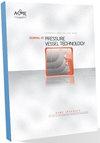美国机械工程师协会(ASME)规范第11章弯曲应力下高韧性延性管道允许裂纹角的稳定性
IF 1.4
4区 工程技术
Q4 ENGINEERING, MECHANICAL
Journal of Pressure Vessel Technology-Transactions of the Asme
Pub Date : 2022-05-19
DOI:10.1115/1.4054620
引用次数: 1
摘要
ASME规范第XI节规定了存在周向缺陷的管道的允许应力。应力由全塑性坍塌应力和安全系数决定。塑性坍塌应力由极限荷载标准估计,该标准也由ASME规范第XI节提供。当管道在缺陷位置施加的应力小于允许应力时,缺陷在评估期结束时是可接受的。允许应力是针对电厂运行的各种服务水平条件进行分类的。当管壁较薄时,部分贯穿缺陷很容易发展为贯穿壁缺陷,冷却剂泄漏的可能性很高。ASME规范第XI节规定了薄壁管道通孔缺陷的最终允许缺陷角度。最终允许角度目前应用于管道,以便在零件贯穿缺陷变为贯穿壁缺陷时保持结构公差。为了确保这种稳定性不受影响,将贯穿壁缺陷的塑性坍塌应力与容许应力相结合。然而,薄壁管道的穿透壁缺陷的最终允许角度尚未确定。本文比较了管道贯穿壁缺陷的塑性坍塌应力和部分贯穿缺陷的许用应力。这些应力的比较用于推导贯穿壁缺陷的最终允许角度。角度可以用精确解的形式表示,也可以用适用于各种服务水平条件的传统选项表示。本文章由计算机程序翻译,如有差异,请以英文原文为准。
Stability of Allowable Flaw Angles for High Toughness Ductile Pipes Subjected to Bending Stress in the ASME Code Section XI
Allowable stresses for pipes with circumferential flaws are provided by the ASME Code Section XI. The stresses are determined by fully plastic collapse stresses and safety factors. The plastic collapse stresses are estimated by Limit Load Criteria, which are also provided by the ASME Code Section XI. When applied stresses of the pipes at the flaw locations are less than the allowable stresses, the flaws are acceptable for the end-of-evaluation period. The allowable stresses are categorized for various service level conditions of the plant operation.
When pipe walls are thin, part-through flaws can easily develop into through-wall flaws, and the likelihood of coolant leakage is high. The ASME Code Section XI provides final allowable flaw angles of through-wall flaws for thin-walled pipes. The final allowable angles are currently applied to pipes in order to maintain structural tolerance if the part-through flaws become through-wall flaws. To ensure that this stability is not compromised, plastic collapse stresses for through-wall flaws are combined with the allowable stresses. However, the final allowable angles of through-wall flaws are not identified for thin-walled pipes.
This paper compares plastic collapse stresses of through-wall flaws and allowable stresses of part-through flaws for pipes. The comparison of these stresses is used to derive the final allowable angles of through-wall flaws. The angles can be expressed either in the form of exact solutions or as conventional options that are appropriate for various service level conditions.
求助全文
通过发布文献求助,成功后即可免费获取论文全文。
去求助
来源期刊
CiteScore
2.10
自引率
10.00%
发文量
77
审稿时长
4.2 months
期刊介绍:
The Journal of Pressure Vessel Technology is the premier publication for the highest-quality research and interpretive reports on the design, analysis, materials, fabrication, construction, inspection, operation, and failure prevention of pressure vessels, piping, pipelines, power and heating boilers, heat exchangers, reaction vessels, pumps, valves, and other pressure and temperature-bearing components, as well as the nondestructive evaluation of critical components in mechanical engineering applications. Not only does the Journal cover all topics dealing with the design and analysis of pressure vessels, piping, and components, but it also contains discussions of their related codes and standards.
Applicable pressure technology areas of interest include: Dynamic and seismic analysis; Equipment qualification; Fabrication; Welding processes and integrity; Operation of vessels and piping; Fatigue and fracture prediction; Finite and boundary element methods; Fluid-structure interaction; High pressure engineering; Elevated temperature analysis and design; Inelastic analysis; Life extension; Lifeline earthquake engineering; PVP materials and their property databases; NDE; safety and reliability; Verification and qualification of software.

 求助内容:
求助内容: 应助结果提醒方式:
应助结果提醒方式:


